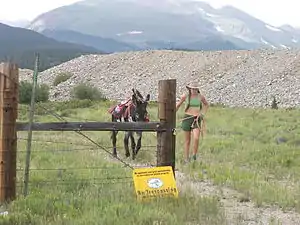Pack burro racing
Pack burro racing is a sport indigenous to the State of Colorado which is deeply rooted in the state's mining heritage.[1] In the early days of the mining industry in Colorado, miners would take burros, which is the Spanish word for donkeys, through the mountains of Colorado while prospecting. Because the burros were carrying supplies, the miners could not ride the animals and so they would walk, leading the donkey. The Burro Races, which are held throughout small towns in Colorado, commemorate these men and women and their burros. In 2012, Pack burro racing was recognized as the official summer heritage sport in Colorado.[2]

Format
In a typical burro race, a runner and a burro travel a prescribed course together, with the runner leading the burro on a rope. Riding of the burro is not allowed. In fact, the human may carry the burro, but the burro may not carry the human.[3] The burro must be on a lead rope, which is limited to 15 feet (4.6 m). Runners must maintain control of their animals at all times. Burros must also carry a pack saddle with 33 pounds (15 kilograms) of traditional mining gear, which must include a pick, a gold pan, and a shovel. Runners may also include other gear in their pack saddles, such as windbreakers, water, food, etc., but the surplus gear cannot be counted in the 33 lbs. Cruelty to the burro is prohibited and racing officials have the right to hold any burro for 30 minutes following the race for an inspection by a veterinarian.[4]
Lore
There are two legends concerning the beginning of these burro races. The first states that the races began when two miners found gold in the same location at the same time and had to race back to town to get to the claims office first. Because they could not ride the burros (the burros were either too small or loaded down with supplies), the miners were forced to run, leading the burros.
Competition
Like Horse Racing, Burro Racing has its own "Triple Crown", consisting of three races.
Fairplay
The Fairplay race is 29 miles (47 km) and counts as an ultra-marathon. It takes place in late July as part of Fairplay's Burro Days town festival. The race begins on the main street and goes to the top of Mosquito Pass.
Leadville
The Leadville race is 22 miles. It takes place the first full weekend of August, typically a week after the Fairplay race, as part of the Leadville's Boom Days city festival. The race goes to the top of Mosquito Pass, then comes back into town through the California Gulch Mining District, past the site of Oro City.
Buena Vista
The Buena Vista race is 12 miles. It typically takes place a week after the Leadville race as part of Buena Vista's Gold Rush Days festival.
Other races
In addition to the Colorado Triple Crown Races, other mining towns throughout Colorado are adding burro races to their event schedule, usually as part of an existing town festival, and these towns include:
- Georgetown, Colorado
- Cripple Creek, Colorado
- Idaho Springs, Colorado
- Creede, Colorado
- Victor, Colorado
- Frederick, Colorado
Outside Colorado, versions of this sport have historically been enjoyed in other states going back to the 1950s in Big Bear, CA with the Old Miners Days Burro Race ; and in the 1960s in Beatty, NV which hosted their annual Burro Race using a ready supply of wild burros from the historic Bullfrog Mining District.
Nowadays, the excitement generated by Colorado’s enthusiastic embrace of the sport is now beginning to fuel an interest in other western states. In 2019, Superior, AZ celebrated its own mining and burro history with the Arizona inaugural Superior Burro Run. In 2020, organizers in both California and New Mexico plan to host their own versions of the event with inaugural races in both states.
References
- Christopher McDougal (8 December 2016). "What Donkeys Know About Autism". New York Times. Retrieved 9 December 2016.
- "HOUSE JOINT RESOLUTION 12-1021" (PDF). 2012.
- "Rules". Retrieved 2 June 2011.
- "Rules". Retrieved 2 June 2011.